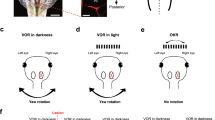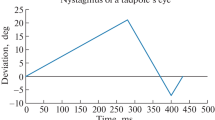Summary
In the Southern Clawed Toad,Xenopus laevis, the compensation of vestibular induced behavioural deficits were investigated in relation to development.
In hemilabyrinthectomized tadpoles and juveniles, the time of compensation for movement and eye posture defects depends on the time of operation. As a rule, the older the animals are at the time of operation the longer the time of compensation. During the prometamorphic stages, movement defects are compensated faster than the asymmetrical eye posture.
In all developmental stages, sequential destruction of the labyrinths causes behavioural defects as if an intact animal was operated only on one side. Therefore, although in many old hemilabyrinthectomized tadpoles and juveniles no compensation can be observed these experiments prove the existence of compensation processes. In young tadpoles, the defects caused by the second operation persist for less than 10 d, while in older tadpoles these asymmetrical defects can last for many weeks, depending on the time interval between both operations. As a rule, the loss of compensation is quicker in the dynamic vestibulo-spinal than in the static vestibulo-ocular pathway. Nevertheless, after a long time all sequentially operated animals behave like simultaneously operated ones, which never compensate the loss of labyrinthine inputs.
The results indicate on different time courses in the development of the two vestibular pathways which may also be caused by a non-synchronously internal functional development of the cerebellum and/or other brain nuclei connected with the vestibular pathways.
Similar content being viewed by others
References
Brodal A (1974) Anatomy of the vestibular nuclei and their connections. In: Kornhuber HH (ed) Vestibular system, part 1, Basic mechanisms. Springer, Berlin Heidelberg New York (Handbook of sensory physiology, vol VI/1), pp 239–352
Cotman CW, Lynch GS (1976) Reactive synaptogenesis in the adult nervous system. The effects of partial deafferentation on new synapse formation. In: Barondes S (ed) Neuronal Recognition. Plenum Press, New York, pp 69–108
Curthoys JS (1979a) The development of function of horizontal semicircular canal primary neurons in the rat. Brain Res 167:41–52
Curthoys JS (1979b) The vestibular-ocular reflex in newborn rats. Acta Otolaryngol (Stockh) 87:484–489
Dichgans J, Brandt T (1978) Visual-vestibular interaction effects on self-motion perception and postural control. In: Held R, Leibowitz HW, Teuber HL (eds) Perception. Springer, Berlin Heidelberg New York (Handbook of sensory physiology, vol VIII), pp 755–804
Dieringer N, Precht W (1979) Synaptic mechanisms involved in compensation of vestibular function following hemilaby-rinthectomy. In: Granit R, Pompeiano O (eds) Reflex control of posture and movement. Elsevier, North Holland, Biomed Press, Amsterdam New York
Dieringer N, Precht W (1981) Functional restitution of static and dynamic reflexes in the frog after hemilabyrinthectomy. In: Flohr H, Precht W (eds) Lesion-induced neuronal plasticity in sensorimotor systems. Springer, Berlin Heidelberg New York, pp 184–196
Dufossé M, Ito M, Jastreboff PJ, Miyashita Y (1978) A neuronal correlate in rabbit's cerebellum to adaptive modification of the vestibulo-ocular reflex. Brain Res 150:611–616
Fish MW, Windle WF (1932) The effect of rotatory stimulation on the movements of the head and eyes in newborn and young kittens. J Comp Neurol 54:103–107
Flandrin JM, Courjon JH, Jeannerod M (1979) Development of vestibulo-ocular response in the kitten. Neurosci Lett 12:295–299
Gall C, McWilliams R, Lynch G (1980) Accelerated rates of synaptogenesis by ‘sprouting’ afferents in the immature hippocampal formation. J Comp Neurol 193:1047–1061
Giersberg H, Rietschel P (1967) Vergleichende Anatomie der Wirbeltiere, Bd 1, Integument, Sinnesorgane, Nervensystem. Fischer, Jena
Hard E, Larsson K (1975) Development of air-righting in rats. Brain Behav Evol 11:53–59
Hillman DE (1976) Morphology of peripheral and central vestibular systems. In: Llinás R, Precht W (eds) Frog neurobiology. Springer, Berlin Heidelberg New York, pp 452–480
Horn E, Rayer B (1978) Compensation of vestibular lesions in relation to development. Naturwissenschaften 65:441
Hughes A (1976) Metamorphic changes in the brain stem and and spinal cord. In: Llinás R, Precht W (eds) Frog neurobiology. Springer, Berlin Heidelberg New York, pp 856–862
Jacobson M (1978) Developmental neurobiology. Plenum Press, New York London
Jeannerod M, Courjon JH, Flandrin JM, Schmid R (1981) Supravestibular control of vestibular compensation after hemilabyrinthectomy in the cat. In: Flohr H, Precht W (eds) Lesion-induced neuronal plasticity in sensorimotor systems. Springer, Berlin Heidelberg New York, pp 208–220
Lang HG, Horn E (1980) The development of the static vestibulo-ocular reflex inXenopus. Z Naturforsch 35c:1122–1123
Lannou J, Precht W, Cazin L (1979) The postnatal development of functional properties of central vestibular neurons in the rat. Brain Res 175:219–232
Larsell O (1967) The comparative anatomy and histology of the cerebellum from myxinoids through birds. University Minnesota Press, Minneapolis
Llinás R, Walton K (1979) Vestibular compensation: a distributed property of the central nervous system. In: Asanuma H, Wilson WJ (eds) Integration in the nervous system. Igaku-Shoin, Tokyo New York, pp 145–166
Nieuwenhys R, Opdam P (1976) Structure of the brain. In: Llinás R, Precht W (eds) Frog neurobiology. Springer, Berlin Heidelberg New York, pp 811–855
Nieuwkoop PD, Faber J (1975) Normal table ofXenopus laevis (Daudin). North-Holland, Amsterdam
Ornitz EM, Atwell CW, Walter DO, Hartman EE, Kaplan AR (1979) The maturation of vestibular nystagmus in infancy and childhood. Acta Otolaryngol (Stockh) 88:244–256
Paterson NF (1948) The development of the inner ear ofXenopus laevis. Proc Zool Soc (Lond) 119:269–291
Precht W (1976) Physiology of the peripheral and central vestibular systems. In: Llinás R, Precht W (eds) Frog neurobiology. Springer, Berlin Heidelberg New York, pp 481–512
Precht W (1978) Neuronal operations in the vestibular system. Springer, Berlin Heidelberg New York
Precht W (1983) The role of multisensory convergence in functional recovery after neural lesions. In: Horn E (ed) Multimodal convergences in sensory systems. Fischer, Stuttgart New York (in press)
Romand R, Danzat M (1982) Modification of spontaneous activity in primary vestibular neurons during development in the cat. Exp Brain Res 45:265–269
Rossi LN, Pignataro O, Nino LM, Gaini R, Sambataro G, Oldini C (1979) Maturation of vestibular responses: preliminary report. Dev Med Child Neurol 21:217–224
Ryu JH, McCabe BF (1976) Central vestibular compensation. Arch Otolaryngol 102:71–76
Sachs L (1974) Angewandte Statistik. Springer, Berlin Heidelberg New York
Schaefer KP, Meyer DL (1973) Compensatory mechanisms following labyrinthine lesion in the Guinea-pig. A simple model of learning. In: Zippel HP (ed) Memory and transfer of information. Plenum Press, New York, pp 203–232
Schaefer KP, Meyer DL (1974) Compensation of vestibular lesions. In: Kornhuber HH (ed) Vestibular system, part 2, Psychophysics, applied aspects and general interpretations. Springer, Berlin Heidelberg New York (Handbook of sensory physiology, vol VI/2), pp 463–491
Ten Kate J (1969) The vestibulo-ocular reflex of the growing pike. Thesis, Rijksuniversiteit Groningen
Windle WF, Fish MW (1932) The development of the vestibular righting reflex in the cat. J Comp Neurol 54:85–96
Author information
Authors and Affiliations
Rights and permissions
About this article
Cite this article
Rayer, B., Cagol, E. & Horn, E. Compensation of vestibular-induced deficits in relation to the development of the Southern Clawed Toad,Xenopus laevis daudin. J. Comp. Physiol. 151, 487–498 (1983). https://doi.org/10.1007/BF00605466
Accepted:
Issue Date:
DOI: https://doi.org/10.1007/BF00605466




